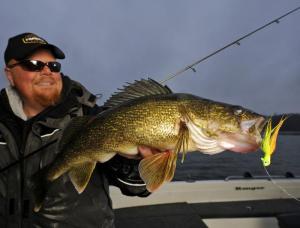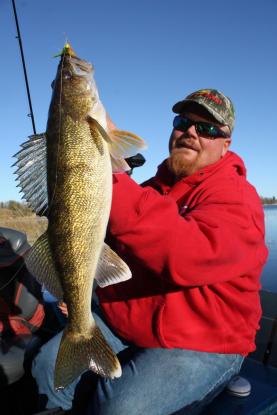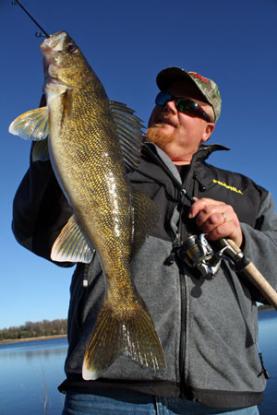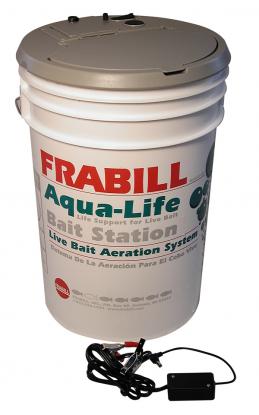It’s early in the season. The labor of spawning is a fling of the past – the breeders are well rested. Water temps are in that magical range – above 50 but no higher than the low 70s. Walleyes are licking their chops and under the impression that the next minnow or jig that eases by is a complimentary meal – big mistake.
 The fishing IS good, so don’t over-think your approach. Trust me, if you write down these tips on your hand with a Sharpie – ala Sarah Palin’s cheat-sheet technique – you will bet bit and not blow a brain chip doing so.
The fishing IS good, so don’t over-think your approach. Trust me, if you write down these tips on your hand with a Sharpie – ala Sarah Palin’s cheat-sheet technique – you will bet bit and not blow a brain chip doing so.
Unearthing Eaters
Sort of hate the term because it implies certain fate by fryer. But you know what I’m talking about – small to midsize fish, typically males. They’re the easiest to locate and lasso this time of year. And without giving it a second thought, my initial probing starts over gravel flats. On a typical natural lake that puts you in 6 to 12 feet of water. If the water’s clearer than moonshine, though, slip out into the 18 to 22 foot range. In both instances, if weeds and or a shoreline point are involved, more power to you.
My second nod goes to a raging river mouth – something significant that walleyes either use to breed or chokes-up with baitfish. A river mouth is actually a broader, more dynamic area than the name implies, too. Relative to that reality, check the actual mouth, upstream a spell if navigable, as well as the spillway up to a quarter mile out into the lake. Watch your electronics and pay close attention for signs of a deeper river channel. Those cuts can be killer.
 Satisfying Slobs
Satisfying Slobs
These are not for eating. Got it? Trusting that you’re an ethical angler, I’m going to give you my top terrain for finding giant early season walleyes. Ready? Rocks, big rocks. Deep or shallow, I’ve caught more slovenly, spawned out females amongst boulders than anywhere else. These sows are hungry, too, but not inclined to chase bait around. Rather, they hunker down in an ambush stance and wait for deliveries. I’m convinced that they’re waiting for me to lower a sumo-sized minnow on a rig or jig. Rarely does a year pass when I don’t pin a couple of trophies on the Minnesota Opener using Popsicle sized shiners or chubs.
Secret Structure
Rocks are regular. Sand the same. And points, well, very predictable. So here’s an arrow to add to the quiver that you might not already own. Clam beds. They’re pretty prevalent on large lakes and generally colonize in 6 to 10 feet of water inside, or just beyond the outside weedline. And with foliage not yet totally in place, now’s the time to find them. (By midsummer clam beds can get buried in greens and be virtually undetectable.)
Paramount to fishing clam beds is not dragging the bottom or you’ll get cut-off more times than a Vespa in downtown New York traffic. Clam beds are constructed of both the living and the dead. And the last gasp of a clam leaves an open shell that’s sharpened to slash fishing line.
With that in mind, I “float” a jig overhead. Close to the bottom, maybe ticking it once to get a reference point, but then maintain a lofting and swimming motion that steers clear of the cutlery. Hair jigs are the ultimate vehicle for hovering over clam beds. The plume of a marabou tail or airy hairs of a bucktail jig provide a tempting target with a relaxed fall fit for such operations. And there’s no doubt, Northland’s new Buck-A-Roo hair jig is the ultimate anti clam digger. It floats like a butterfly and stings like a bee.
 Rigging Ritual
Rigging Ritual
Launch and look around. There’s probably a 50/50 split between guys jigging and rigging. I have no qualms with either party, either. Both are classic methods for rolling cold water walleyes. But this year, just for poops and giggles, experiment with my hybridized presentation. It blends the best of both worlds.
Think of it like an undersized live bait rig that can be pitched like a jig. Build it this way: Space roughly 18-inches between your hook and a fixed position bullet sinker. I use Northland’s ingenious Sling-Shot Worm Weight because they affix to the line – without nicking and twisting it – and stay put without a swivel. Moreover, you can change weights without retying. To complete the rig, simply tie in a #6 or even smaller #8 hook. In this application, smaller hooks are preferred because they aren’t a prone to snagging.
Dress the rig with minnow, half a crawler, or my favorite, especially in early summer, a medium black leech. Rear back and pitch it like a jig. Twitch it back in 2-foot strides, each action followed by a 3-second settling period to let the bait fall to a potential death by walleye.
I haven’t officially named the rig yet, but will, and shortly, so nobody else claims it… Oh, and by the way, the No Name Rig is most effective over shallow rocks and for slipping through emerging vegetation.
Alive and Kicking
That Buck-A-Roo jig I just mentioned? You can bet it’ll be buddy-buddy with a live minnow in my boat. In fact, other than stroking my No Name Rig and a leech at rocks and weeds, minnows will be responsible for the rest of the dirty work. And hands-down, locally-trapped, shiner minnows are the best of show. Nothing outdoes what the lake is actually serving. The shiners are in. The walleyes are in because of the shiners. So don’t fool with Mother Nature.
 Fragile as they are, the slightest scrape of a hook puts a shiner into a traumatized twist that walleyes enjoy to watch, albeit sadistically. The flashing silvery sides are like flicking a flashlight at night when you’re trying to hide in the woods playing tag. (That was a childhood reference by the way, not something I do on weekends.) A flash of a flank of a shiner and the jig is up, literally.
Fragile as they are, the slightest scrape of a hook puts a shiner into a traumatized twist that walleyes enjoy to watch, albeit sadistically. The flashing silvery sides are like flicking a flashlight at night when you’re trying to hide in the woods playing tag. (That was a childhood reference by the way, not something I do on weekends.) A flash of a flank of a shiner and the jig is up, literally.
That delicate nature also presents a problem. Shiners are easily shocked and you can burn a lot of hard earned money if they aren’t handled with TLC. For the big transport – going from the bait store to camp, which might be hours away – I transfer them into Frabill’s 6-gallon Personal Bait Station. The insulated, highly-oxygenated container is my brother’s keeper when it comes to mobilizing shiners. Once in the boat, I’ll divide the minnows into smaller 8-quart Personal Bait Stations. The low-profile, rectangular container is stable and as easy to pass around as a cold one.
Speaking of which, I’m a tad thirsty. I think there’s one in the cooler.
Editor’s Note: Brian “Bro” Brosdahl headmans Bro’s Guide Service in North Central Minnesota. Spring, Summer, Winter or Fall, the northwoods fish stalker chases everything from walleyes and panfish to bass and perch. Bro can be reached at 218-340-6051 or visit his website at www.brosguideservice.com.










